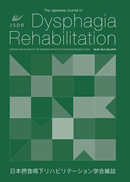Volume 5, Issue 2
The Japanese Journal of Dysphagia Rehabilitation
Displaying 1-7 of 7 articles from this issue
- |<
- <
- 1
- >
- >|
Review Article
-
2001 Volume 5 Issue 2 Pages 105-112
Published: December 30, 2001
Released on J-STAGE: July 19, 2020
Download PDF (3642K)
Original Paper
-
2001 Volume 5 Issue 2 Pages 113-120
Published: December 30, 2001
Released on J-STAGE: July 19, 2020
Download PDF (2954K) -
2001 Volume 5 Issue 2 Pages 121-127
Published: December 30, 2001
Released on J-STAGE: July 19, 2020
Download PDF (2948K) -
2001 Volume 5 Issue 2 Pages 128-137
Published: December 30, 2001
Released on J-STAGE: July 19, 2020
Download PDF (4185K)
Clinical Report
-
2001 Volume 5 Issue 2 Pages 138-143
Published: December 30, 2001
Released on J-STAGE: July 19, 2020
Download PDF (2557K) -
2001 Volume 5 Issue 2 Pages 144-149
Published: December 30, 2001
Released on J-STAGE: July 19, 2020
Download PDF (2648K) -
2001 Volume 5 Issue 2 Pages 150-156
Published: December 30, 2001
Released on J-STAGE: July 19, 2020
Download PDF (3004K)
- |<
- <
- 1
- >
- >|
